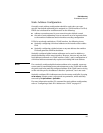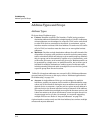
3-11
IPv6 Addressing
Address Types and Scope
Address Scope
The address scope determines the area (topology) in which a given IPv6
address is used. This section provides an overview of IPv6 address types. For
more information, refer to the chapter titled “IPv6 Addressing”.
Link-Local Address. Limited to a given interface (VLAN). Enabling IPv6 on
a given VLAN automatically generates a link-local address used for switched
traffic on the VLAN.
Global Unicast Address. Applies to a unique IPv6 routable address on the
internet. A unique global address has a routing prefix and a unique device
identifier.When autoconfiguration is enabled on a VLAN receiving an IPv6
router advertisement (RA), the prefix specified in the RA and the device
identifier specified in the link-local address are combined to create a unique,
global unicast address. A global unicast address can also be statically config-
ured to either replace or complement an automatically configured address of
the same type.
Unique Local Unicast. Applies to a routable, globally unique address
intended for use within an entity defined by the system adminstrator, such as
a specific site or a group of related sites defined by IPv6 border routers. These
addresses are intended to be routable on a local site or an organization's
intranet, but are not intended to be routed on the global internet. A unique
local unicast address has the same format as a global unicast address. In this
guide, unless otherwise stated, information on global unicast addresses also
applies to unique local unicast addresses. For more on this topic, refer to
“Unique Local Unicast IPv6 Address” on page 3-19.
Unicast Address Prefixes
Traffic having a unicast destination address is intended for a single interface
identified by that address. While IPv6 unicast addresses can have prefixes of
varying length, a 64-bit prefix is generally adequate.
Link-Local Unicast Prefix (fe80): This well-known 64-bit fixed prefix is for
a non- routable address used to identify a device on a single VLAN interface,
and requires the high-order ten bits to be set to fe80 (fe80::/10). The remaining
54 bits in the prefix are set to zeros, followed by an interface ID of 64 bits.
fe80:0000:0000:0000:0215:60ff:fe7a:adc0/64
or
fe80::215:60ff:fe7a:asc0/64


















